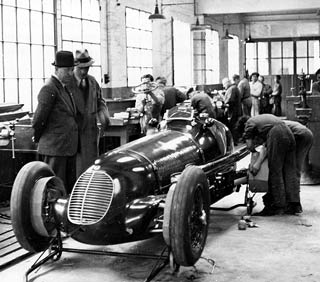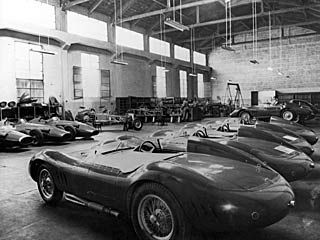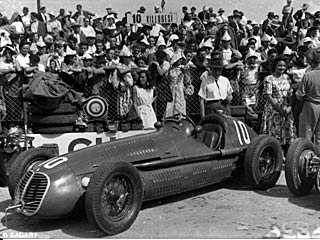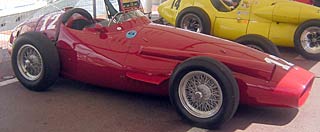GPÕs contested: 63 (1950 till 1960)
Pole position: 10
Victories: 9 (Monaco 1948, 1956, 1957)
Fastest lap: 15
World Championship for Constructors points: 1958 - 5th - 10pts
Manufacturer of racing cars and sports cars, established on December 1, 1914 in Bologna.The Maserati brothers, Alfieri Maserati, Bindo Maserati, Carlo Maserati, Ettore Maserati, Ernesto Maserati and Mario Maserati, were all involved with automobiles from the beginning of the 20th century. Alfieri, Bindo and Ernesto built 2-litre Grand Prix cars for Diatto. In 1926, Diatto suspended the production of race cars, leading to the creation of the first Maserati and the founding of the Maserati marque. One of the first Maseratis, driven by Alfieri, won the 1926 Targa Florio. Maserati began making race cars with 4, 6, 8 and 16 cylinders (actually two straight eights mounted parallel to one another). Mario, an artist, is believed to have devised the company's trident emblem, based on one the Fontana del Nettuno, Bologna. Alfieri Maserati died in 1932 but three other brothers, Bindo, Ernesto and Ettore, kept the firm going, building cars that won races.
In 1937, the remaining Maserati brothers sold their shares in the company to the Adolfo Orsi family, who in 1940 relocated the company headquarters to their hometown of Modena, where it remains to this day. The brothers continued in engineering roles with the company. Racing successes continued, even against the giants of German racing, Auto Union and Mercedes. In 1939, a Maserati 8CTF won the Indianapolis 500, a feat repeated the following year.
The war then intervened, Maserati abandoning cars to produce components for the Italian war effort. During this time, Maserati worked in fierce competition to construct a V16 towncar for Benito Mussolini before Ferry Porsche of Volkswagen built one for Adolf Hitler. They failed in this endeavour and the plans were scrapped. Once peace was restored, Maserati returned to making cars, the Maserati A6 series, doing well in the post-war racing scene.
Key people will join the Maserati team, Alberto Massimino, an old Fiat engineer, with both Alfa Romeo and Ferrari experiences. He will be in charge of overseeing the design of all racing models for the next ten years. With him will join "ingeniore" Giulio Alfieri (1924-2002),Vittorio Bellentani and Gioacchino Colombo (1903 - 1987), the designer of the V12 Ferrari. The focus was to come with the best engines and the best chassis to succeed in car racing. All these new projects will receive the last contribution of the Maserati brothers, who after the 10-year contract with Orsi, went on to form the O.S.C.A. car builder. This team worked on several projects (Maserati 4CLT, Maserati A6 series, Maserati 8CLT), including one that will be pivotal for the future success of the company: the Maserati A6GCM.
The famous Argentinian driver Juan-Manuel Fangio raced for Maserati for a number of years in the 1950s, producing a number of stunning victories including winning the world championship in 1957 in the Maserati 250F alongside with Toulo de Graffenried, Louis Chiron, Prince Bira, Enrico Platˇ and with a few others. Other racing projects in the 50s were the Maserati 200S, Maserati 300S (with several famous pilots, among these, Benoit Musy), Maserati 350S, Maserati 450S, followed in 1961 by the famous Maserati Birdcage.
Maserati had retired from factory racing participation due to the Guidizzolo accident (1957), though it built racing cars to be raced by others after that date. After 1957, Maserati became more and more focussed on road cars, and chief engineer Giulio Alfieri built the 6-cylinder Maserati 3500 2+2 coupe featuring an aluminum body over Carrozzeria Touring's superleggera structure, a design also used for the small-volume V8-powered Maserati 5000. Next came the Maserati Sebring bodied by Vignale and launched in 1962, the Maserati Mistral Coupˇ (1963) and the Spider (1964), both designed by Pietro Frua, and their first four-door, the Maserati Quattroporte (1963), also designed by Pietro Frua. The two-seater Maserati Ghibli coupe was launched in 1967, followed by a convertible in 1969. harder. |

Brothers Maserati at Bologna works

Adolfo Orsi in Bologna works

Works in Modena |
Maserati 4CLT - 1948/50
Chassis: reworked tubular frame by Alberto Massmino with revised suspension
Engine: Maserati 4 cyl of 1490cc, twin supercharged delivering 260 bhp. The 1948 revised 4 cylinder engine became a main engine for the early 1.5 litre GP years.
Designer: Alberto Massimino
Drivers: Scuderia Ambrosiana, Ascari, Villoresi, Bira, Parnell, Squadra Achille Varzi, Fangio, Campos, de Graffenried, F Karina, Chiron, Froilan Gonzalez, Harry Schell, David Murray |
 |
Maserati 250F - 1952/57
Chassis: multi tubular, wishbone and coil in front, de Dion arrangement in the rear and front mounted engine.
Of the 29 cars build many were modified.
Engine: Maserati straight 6 of 1497 cc with 240 bhp in 1954 and 270 bhp in 1957.
Maserati V12, 3.5 litre in 1957
Designer: Colombo, Bellentani and Alfieri
Drivers: Almost any driver has at one time driven a 250F, among them: Fangio, Moss, Amon, Ascari, Behra, Bonnier, Brabham, Chiron, Collins, Maria Theresa de Filippis, Gonzalez, de Graffenried, Masten Gregory, Hawthorn, Herrmann, Marimon, Musso, Perdisa, Rosier, Salvadori, Schell, Shelby, Simon, Taruffi, de Tomaso, Villoresi, Walker, Wharton
Results: 1958 5th WCC with 10 points, 9 victories, Fangio got his 5th world title driving a 250F |
 |